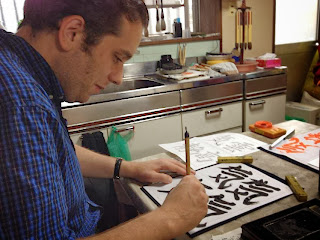Most of you know where this is going already.
So, after two months, things are going pretty well. There are daily challenges to living in any foreign country though. While Japan is very hospitable to gai-jin, there are cultural differences that you need to be prepared for when living and working here. If you don't adapt to those differences, you are almost certainly going to make yourself miserable.

I think the key to living happily is remembering that you are a guest in this country. While you get certain privileges as a guest (and JET ALT's get many privileges), being a guest also entails certain responsibilities. One of those responsibilities is learning to see the world as they see the world. Their sense of decorum now has to become your sense of decorum. You need to follow their etiquette. You should follow their etiquette as a common courtesy, but if not that as a way to make your time here far more agreeable.
It took two things to help me learn this.
I know it sounds a little strange, but after my experience living in Korea, the biggest help to me was reading James Clavell's Shogun. The novel isn't just an incredibly immersive and compelling story, but it also delves deeply into Japanese culture. It taught me the importance of politeness, ceremony and the etiquette that make Japan what it is and such an interesting country. Shogun is the story of the first Englishman who washes up on the shores of Japan in 1600 after he is thrown from his ship after a storm. Blackthorn (or Anjin San) is in Japan, and no one speaks his language and the culture is completely foreign to him. In other words he is a character with whom any visitor to a foreign country can empathize.
I want to preface this part by saying how nice everyone here in Japan has been. The teachers are incredibly nice to me and the Board of Education workers are incredibly kind (when I told them about my bike's flat tire, Hamada-Sensei was at my apartment within ninety minutes to take me to a bicycle repair shop). They have extended many courtesies to me that go well beyond the call of duty as well.
That said, on days where I have felt challenged by a cultural difference, I channel the spirit of John Blackthorn. I honestly ask myself what Anjin-San would do and it was led me to having a copacetic relationship with my employers and co-workers.
For example, when you want to schedule a vacation, you need to learn that the work culture in Japan is defined by hard work and dedication. The focus is not the person, but the team. If you leaving means the team will suffer, then you will not leave. I understand and appreciate that. You also need to learn patience when awaiting your answer. The answers will come in time. If your vacation doesn't work out, it's karma, desu ne?
If they question the fact that you said goodbye in the wrong way, don't take offence and realize that the word you used in that situation could have been quite rude (it's apparently quite rude to say Sayonara to a superior). Accept the constructive criticism and move on.
Anyway, I am feeling quite genki (happy), and I was reflecting on the book that most helped me.
Peace out.

.JPG)

.JPG)











_1892.jpg)






.jpg)





